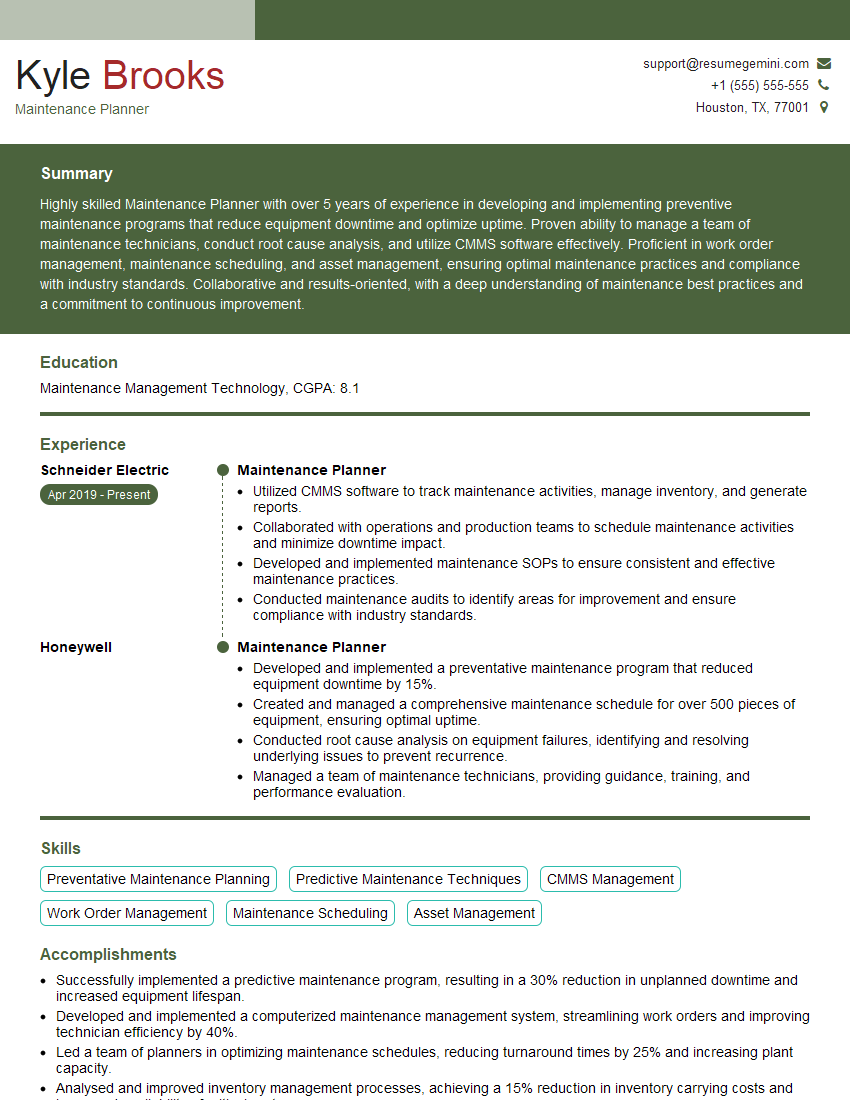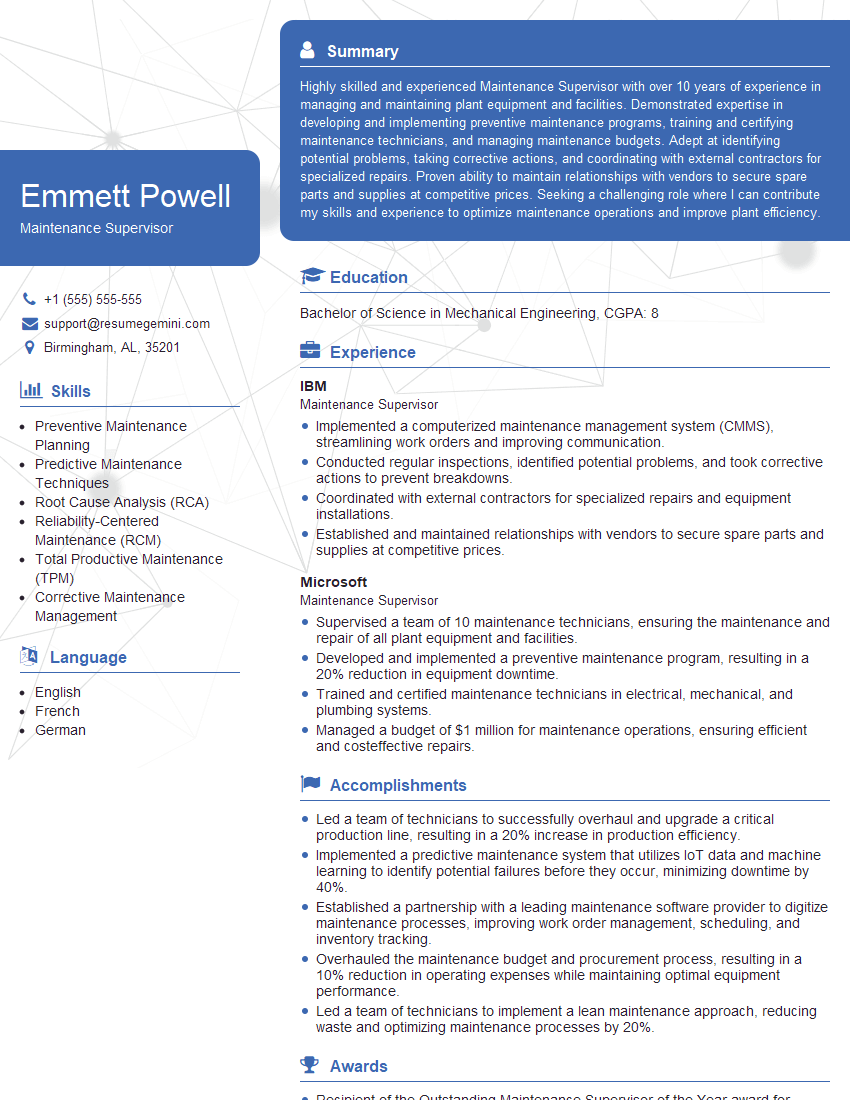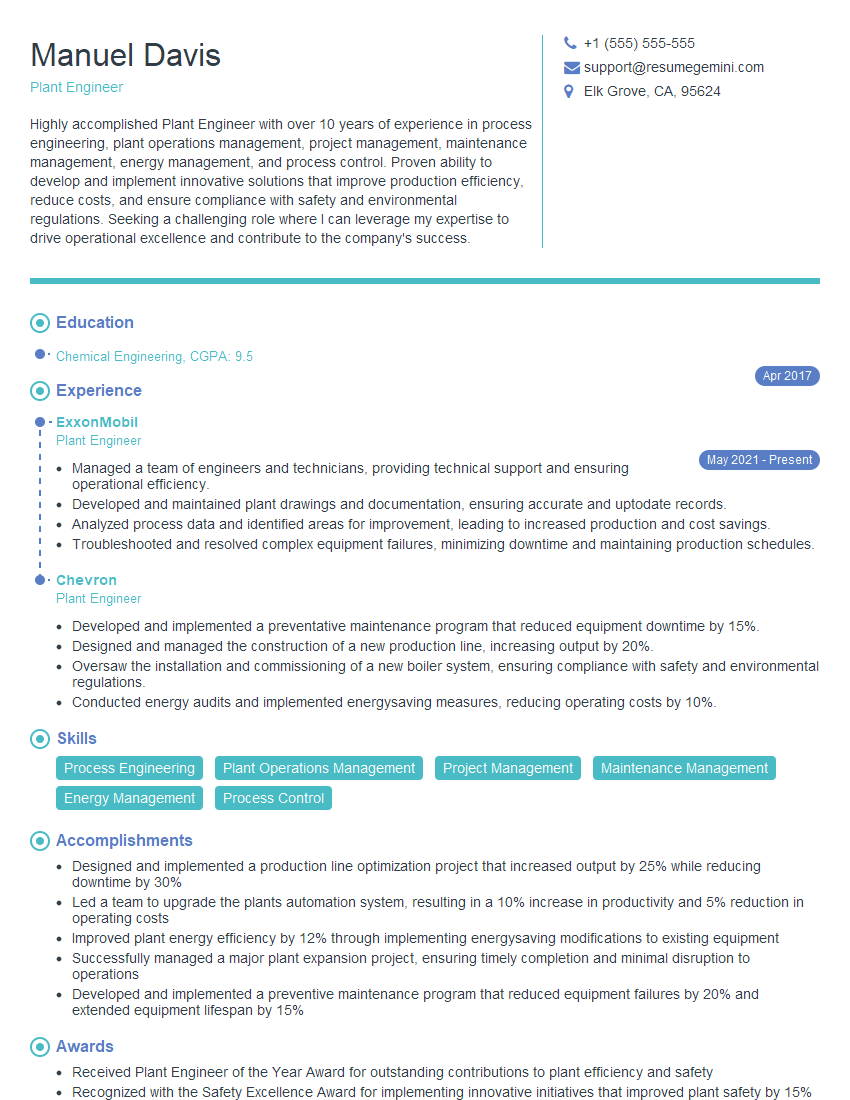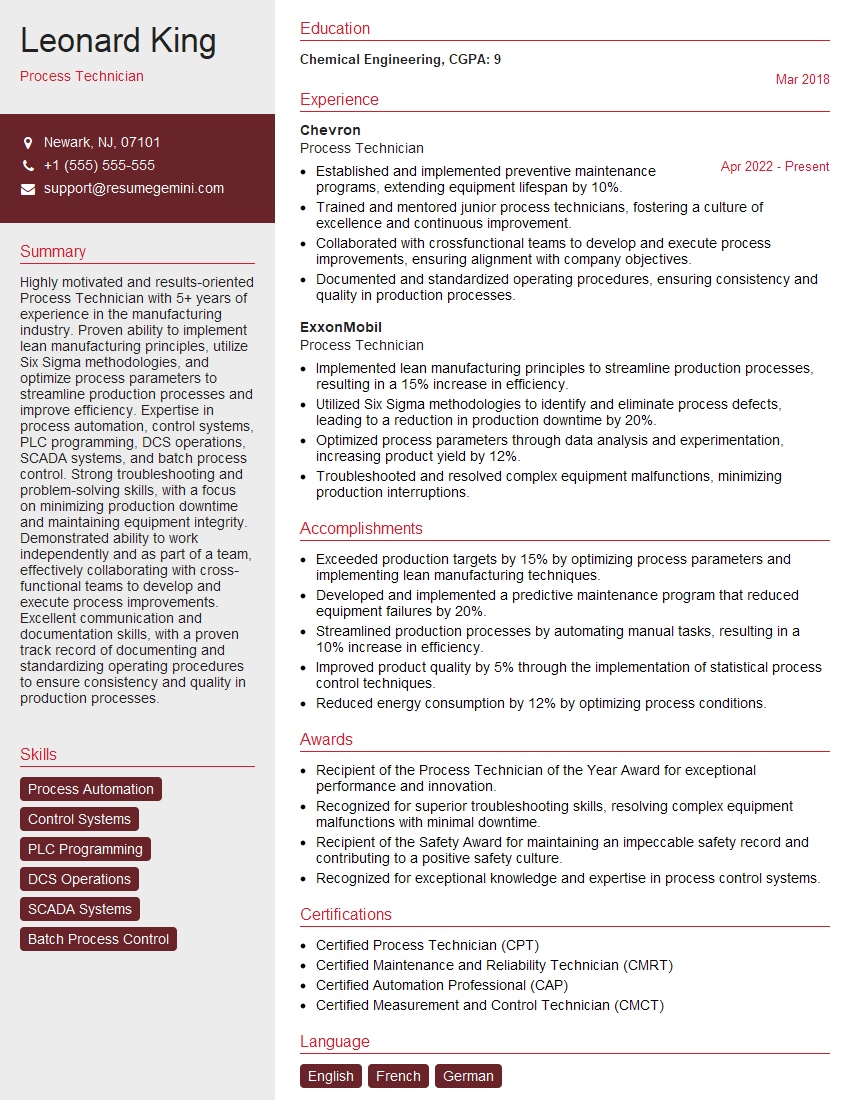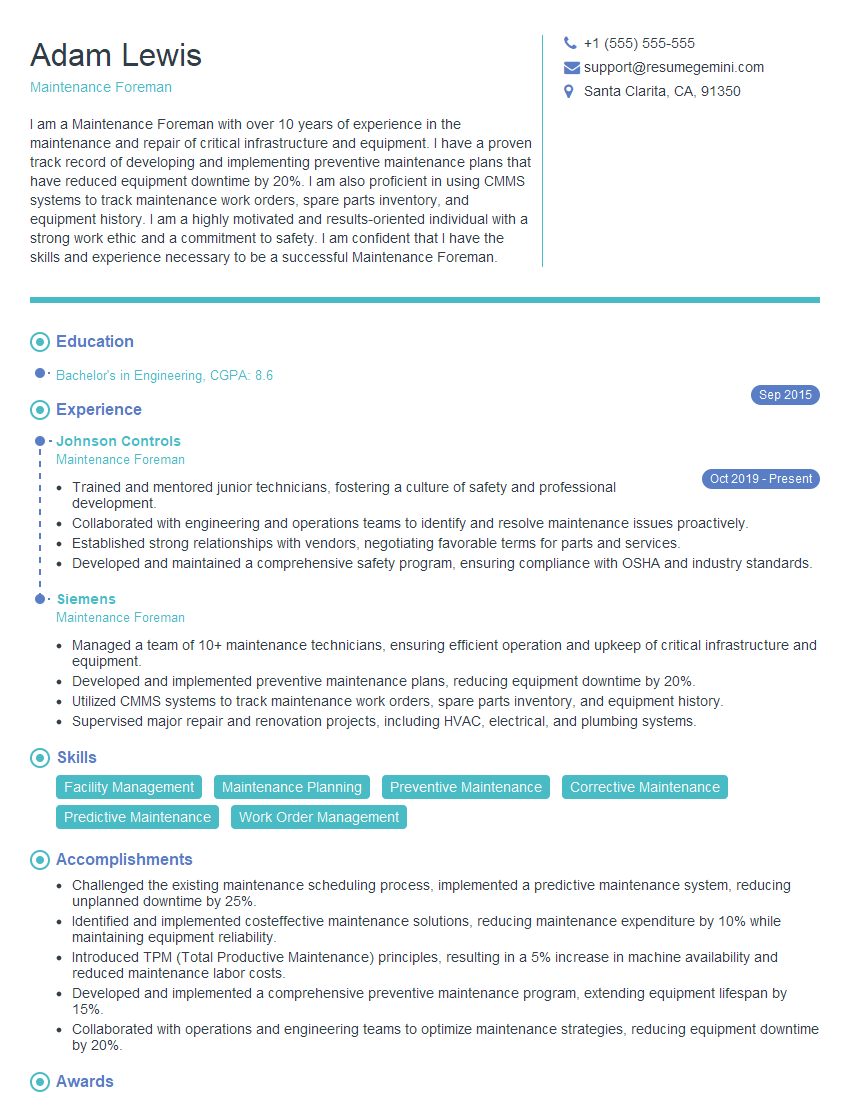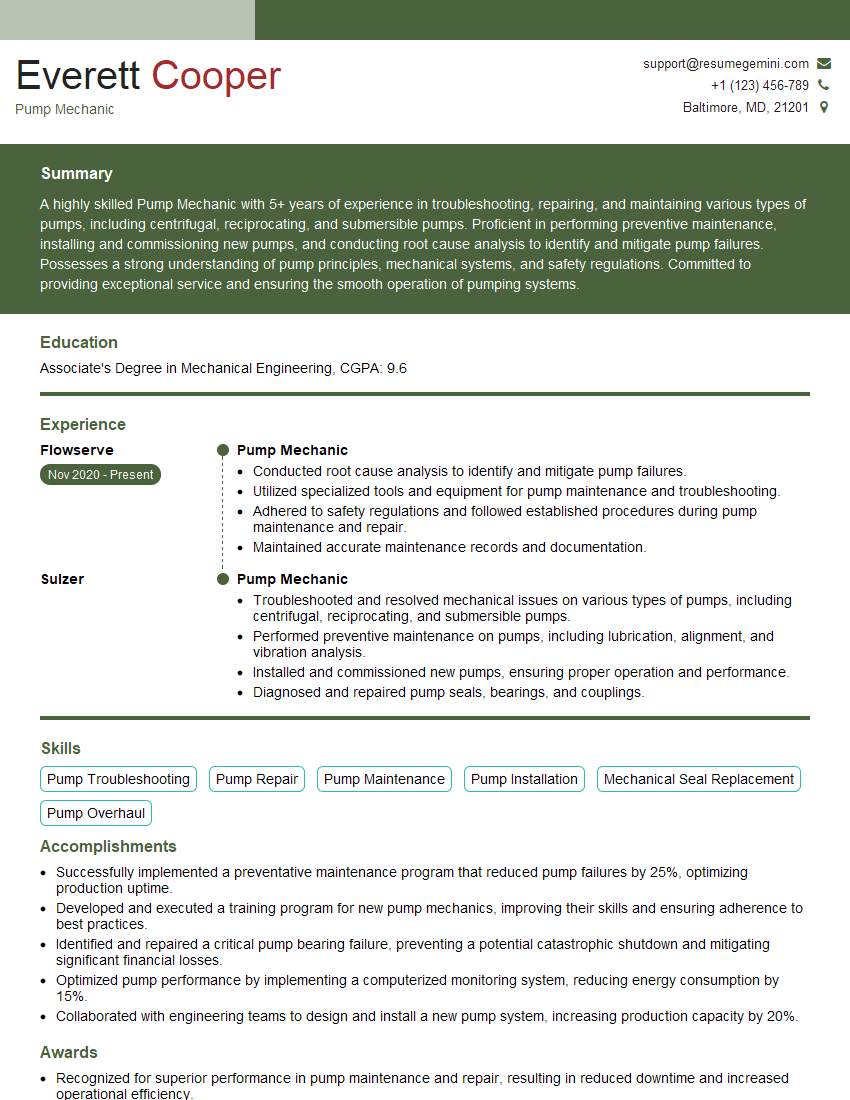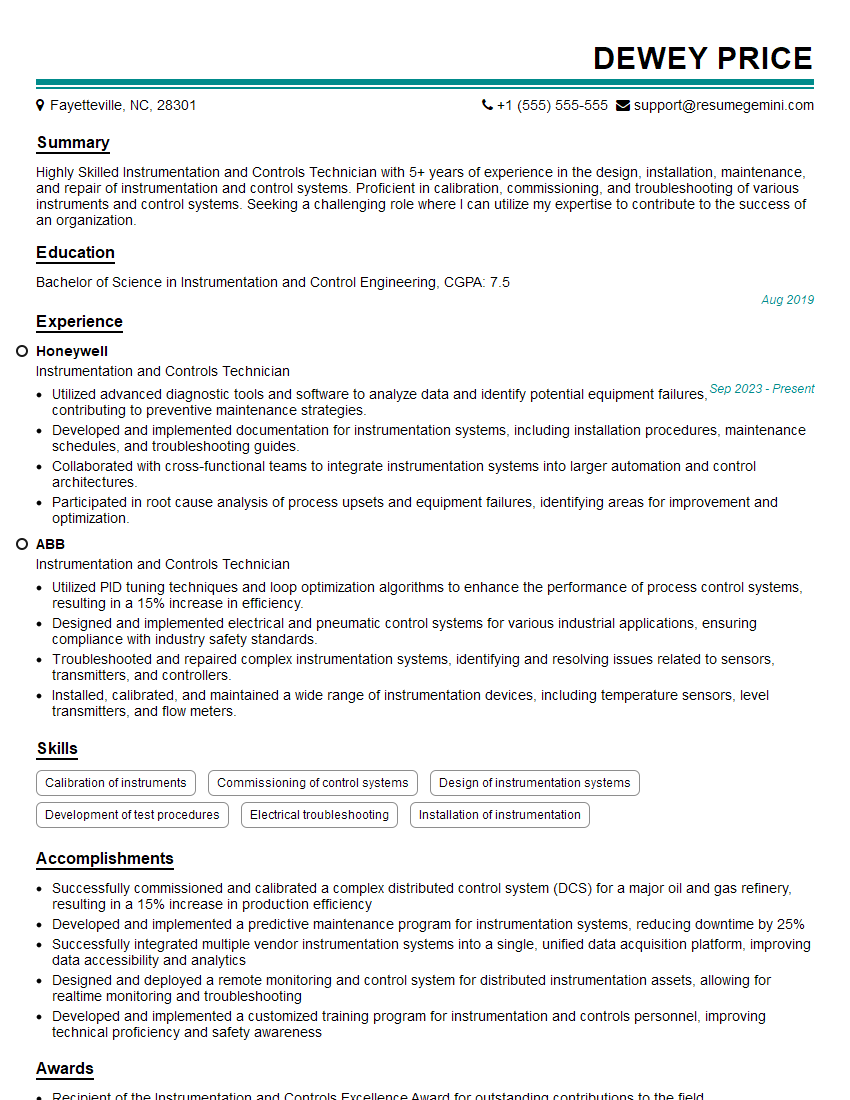Cracking a skill-specific interview, like one for Pump Preventive Maintenance, requires understanding the nuances of the role. In this blog, we present the questions you’re most likely to encounter, along with insights into how to answer them effectively. Let’s ensure you’re ready to make a strong impression.
Questions Asked in Pump Preventive Maintenance Interview
Q 1. Describe your experience with different types of pump seals (mechanical, packing, etc.)
Pump seals are critical components preventing leakage between the pump’s internal fluid and the external environment. I have extensive experience with various types, including mechanical seals and packing seals.
Mechanical seals are precision-engineered components consisting of stationary and rotating faces that create a leak-free barrier. They are preferred for higher pressures and are more efficient than packing seals, requiring less maintenance in many cases. Different types exist, such as single, double, and tandem seals, each suited for specific applications based on pressure, temperature, and fluid characteristics. For instance, in high-pressure applications such as boiler feed pumps, you would opt for a double mechanical seal with barrier fluid to prevent leakage.
Packing seals, on the other hand, use compressible materials like braided graphite or PTFE to create a seal around the rotating shaft. They are simpler and less expensive but require more frequent adjustment and replacement. While suitable for lower-pressure applications, they tend to leak slightly more than mechanical seals, requiring regular monitoring and maintenance. I’ve worked extensively with both seal types on centrifugal, positive displacement and other pump types, troubleshooting issues such as seal face wear, leakage, and misalignment that often lead to seal failure. I have experience with different packing materials selection based on fluid compatibility and operating conditions.
Q 2. Explain the importance of proper lubrication in pump maintenance.
Proper lubrication is paramount for pump efficiency and longevity. Think of it as the lifeblood of the pump’s moving parts. Lubrication reduces friction between moving components, preventing excessive wear, heat generation, and ultimately, premature failure. This is especially crucial for bearings and other rotating elements within the pump. Without sufficient lubrication, these parts overheat, leading to increased vibration, noise, and ultimately, catastrophic failure.
I’ve seen firsthand the devastating consequences of inadequate lubrication—from seized bearings to shaft damage requiring extensive repairs. My approach involves following the manufacturer’s recommendations regarding lubricant type, viscosity, and frequency of lubrication. Regular monitoring of oil levels, temperature, and condition through oil analysis is crucial to ensure optimal performance. I use a combination of scheduled maintenance, predictive maintenance techniques like vibration analysis, and visual inspections to proactively identify potential lubrication issues before they escalate.
Q 3. What are the common causes of pump cavitation and how can it be prevented?
Cavitation is a serious problem in pumps, characterized by the formation and collapse of vapor bubbles within the liquid. The collapsing bubbles create shockwaves that can erode pump components, reducing efficiency and lifespan. It’s like tiny explosions happening inside the pump.
Several factors contribute to cavitation, including:
- Insufficient Net Positive Suction Head (NPSH): This is the most common cause, occurring when the pump’s suction pressure is too low, causing the liquid to vaporize.
- Excessive pump speed: Higher speeds increase the velocity of the liquid, promoting cavitation.
- Clogged suction strainer or line: Restrictions in the suction line reduce flow and increase the chance of cavitation.
- High liquid temperature: Higher temperatures lower the liquid’s vapor pressure, making it more susceptible to cavitation.
Preventing cavitation involves several strategies, focusing on increasing NPSH and reducing the risk factors mentioned above. This might involve modifying the pump’s operating conditions (reducing speed, for example), checking suction line for blockages, ensuring proper priming, or installing a larger suction pipe.
Q 4. How do you identify and troubleshoot a pump that is vibrating excessively?
Excessive vibration in a pump is a strong indicator of underlying problems that need immediate attention. Ignoring it can lead to catastrophic failure. My troubleshooting process begins with identifying the source and magnitude of the vibration.
I typically use vibration analysis instruments to measure the frequency and amplitude of the vibrations. This helps pinpoint the source—imbalanced impellers, worn bearings, misalignment, or even cavitation. Along with vibration analysis, I conduct visual inspections to check for loose bolts, damaged components, and other obvious signs of wear.
For example, a high-frequency vibration often points to bearing problems, while a low-frequency vibration may indicate shaft misalignment. Once the source is identified, the solution can be implemented. This could include rebalancing the impeller, replacing worn bearings, realigning the pump, or addressing cavitation issues.
Q 5. Describe your experience with pump alignment procedures.
Pump alignment is crucial for optimal performance and longevity. Misalignment leads to increased wear, vibration, and ultimately, premature failure. I have considerable experience using various alignment methods, including laser alignment and dial indicator methods. My preferred method is laser alignment as it is more accurate and less time-consuming than dial indicators, particularly in confined spaces.
The process typically involves using precision measuring equipment to ensure perfect alignment between the pump shaft and the driver (e.g., motor). The goal is to minimize the angular and parallel misalignment. Laser alignment tools provide real-time feedback, facilitating accurate adjustments to coupling or feet placement. I always refer to the manufacturer’s alignment specifications as they vary according to pump design and size.
Q 6. What are the key indicators that a pump needs immediate attention?
Several key indicators demand immediate attention to prevent catastrophic failure and costly downtime. These include:
- Excessive vibration or noise: Significantly higher than normal levels indicates a potential problem.
- High temperature rise: Indicates potential problems with lubrication or internal friction.
- Significant reduction in flow rate or pressure: Points to a blockage, wear, or other internal issues.
- Unusual noises (knocking, squealing): Could indicate impending bearing failure or other mechanical problems.
- Leakage: While some small leakage is normal, large leaks are a clear sign that immediate attention is required.
Upon noticing any of these, immediate action is crucial. The situation must be assessed, and corrective actions taken promptly, potentially involving isolating the pump to prevent further damage.
Q 7. How do you perform a visual inspection of a pump?
A visual inspection is the first step in pump maintenance and troubleshooting. It provides a quick overview of the pump’s condition and helps identify any obvious problems. It’s like a quick check-up for your pump.
I begin by carefully examining the pump’s exterior, checking for:
- Leaks: Look for any signs of fluid leakage around seals, couplings, or connections.
- Damage: Check for dents, cracks, or other signs of physical damage to the pump casing or components.
- Loose parts: Look for any loose bolts, nuts, or other fasteners.
- Corrosion: Inspect for rust, scaling, or other signs of corrosion.
- Condition of the couplings: Check for wear, misalignment, or damage.
- Lubrication levels: Verify oil levels in bearings, lubrication points, and oil reservoirs.
The findings from the visual inspection guide subsequent actions, such as more detailed inspections or diagnostic tests. It often points towards the root cause or area for more in-depth investigation.
Q 8. What safety precautions do you take when working on pumps?
Safety is paramount when working on pumps. Before even approaching the equipment, I always ensure the pump is completely isolated from the system. This means shutting down the power supply, isolating valves to prevent unexpected fluid flow, and relieving any pressure within the system. I then use lockout/tagout procedures to prevent accidental restarting. This is crucial to prevent injury from moving parts, high-pressure fluid release, or electrical shock. Personal protective equipment (PPE) is also essential – this includes safety glasses, gloves appropriate for the fluid being handled (e.g., chemical-resistant gloves for corrosive fluids), steel-toe boots, and potentially a hard hat depending on the work environment. Finally, I always inspect the pump visually for any obvious hazards before starting any maintenance tasks.
For example, during a recent maintenance project on a large centrifugal pump handling corrosive chemicals, I meticulously followed the lockout/tagout procedure, verified pressure relief, and donned the appropriate chemical-resistant gloves and safety glasses before even approaching the pump. This meticulous approach ensured a safe and efficient maintenance process.
Q 9. Explain your understanding of pump curves and their significance in maintenance.
Pump curves are graphical representations of a pump’s performance characteristics. They typically show the relationship between flow rate (on the horizontal axis) and head (pressure, on the vertical axis), at various speeds. They also display power consumption (often a separate curve). Understanding pump curves is critical for preventive maintenance because they provide valuable insight into the pump’s operating efficiency and potential problems.
For example, if a pump’s performance shifts significantly from its original curve – perhaps delivering lower flow at a given head – it could indicate wear in the impeller, blockage in the suction line, or issues with the pump’s prime. By comparing current performance to the original curve, we can quickly identify potential issues before they lead to major failures. Regularly reviewing these curves during maintenance allows for proactive adjustments and repairs, maximizing efficiency and longevity of the pump.
Q 10. How do you interpret pump performance data (flow rate, pressure, power consumption)?
Pump performance data – flow rate, pressure, and power consumption – are vital indicators of a pump’s health. Consistent monitoring of these parameters is key for effective preventive maintenance. Changes in these values from established baselines can signify developing problems.
For instance, a decreasing flow rate at constant speed and pressure could signal impeller wear or a clogging issue. An increase in power consumption for the same flow suggests increased friction within the pump, potentially due to bearing wear or misalignment. Similarly, reduced pressure at constant flow and speed could indicate leaks in the system or a problem with the pump’s suction.
I use data loggers and monitoring systems to track these parameters over time, creating a historical record for comparison and trend analysis. This allows for early detection of anomalies, enabling timely interventions, thus preventing major failures and costly downtime.
Q 11. Describe your experience with different types of pump bearings.
I have extensive experience with various pump bearing types, including ball bearings, roller bearings (cylindrical, tapered, spherical), and sleeve bearings. Each type has its advantages and disadvantages. Ball bearings are commonly used for high-speed, lower-load applications, offering good accuracy and minimal friction. Roller bearings excel in high-load situations, while sleeve bearings are often preferred for low-speed, high-load, and dirty environments due to their tolerance for contamination and simplicity.
During my work, I’ve inspected and replaced bearings of all these types, paying close attention to factors like proper lubrication, alignment, and signs of wear such as excessive play, noise, or vibration. For example, I once diagnosed a premature failure of ball bearings in a high-speed centrifugal pump due to insufficient lubrication; replacing the bearings and implementing a proper lubrication schedule resolved the issue permanently.
Q 12. What are the common causes of pump shaft misalignment?
Pump shaft misalignment is a common cause of premature bearing failure, vibration, and reduced efficiency. It’s usually caused by factors such as improper installation, foundation settling, thermal expansion mismatches between the pump and its driver (motor or turbine), or wear in couplings.
Specifically, misalignment can be axial (parallel displacement), radial (angular displacement), or a combination of both. Axial misalignment occurs when the shafts are not parallel to each other, while radial misalignment happens when the centerlines of the shafts do not intersect. Improper coupling installation is a frequent culprit, leading to uneven force distribution and increased stress on pump components.
Precise alignment is crucial for optimal performance and longevity of the pump. I use various tools such as dial indicators, laser alignment systems, and alignment software to ensure accurate alignment during installation and as part of periodic maintenance.
Q 13. How do you perform a pump vibration analysis?
Pump vibration analysis involves measuring the vibrations produced by a pump to identify potential problems. Excessive vibration is a clear indicator of issues like misalignment, imbalance, bearing wear, cavitation, or resonance. The process involves using a vibration analyzer to measure the amplitude, frequency, and phase of vibrations at different locations on the pump.
I typically use handheld vibration analyzers equipped with accelerometers to measure vibrations. The data collected is then analyzed using either Fast Fourier Transforms (FFT) to identify the frequencies of the vibrations, or using a dedicated vibration analysis software. By comparing the measured vibrations to acceptable limits and analyzing frequency patterns, I can identify the source of the problem, allowing for targeted maintenance actions.
For example, a high amplitude vibration at a specific frequency might indicate a bearing defect, while a vibration across a wide range of frequencies could point to misalignment. The analysis helps to proactively address issues before they escalate into major failures.
Q 14. What is your experience with predictive maintenance techniques for pumps?
Predictive maintenance techniques are crucial for optimizing pump reliability and reducing downtime. My experience includes utilizing various methods such as vibration analysis (as described above), oil analysis (monitoring wear particles and degradation products in the lubricating oil), thermography (detecting thermal anomalies indicating overheating), and run-time analysis (monitoring parameters like flow, pressure, and power consumption to detect trends).
By combining these techniques, we can anticipate potential failures before they occur. For example, oil analysis can reveal early signs of bearing wear by detecting metal particles in the oil long before physical symptoms appear. Thermography can detect overheating in motors or bearings, often indicative of developing problems. Run-time analysis can indicate a gradual decline in pump efficiency, signifying impending issues.
Data from these predictive maintenance methods are used to schedule timely maintenance interventions, ensuring optimum pump performance and avoiding unexpected failures, which translates into significant cost savings and improved operational reliability.
Q 15. How do you manage pump spare parts inventory?
Managing pump spare parts inventory effectively is crucial for minimizing downtime and operational costs. It’s not just about having parts; it’s about having the right parts, in the right quantities, at the right time. My approach involves a multi-faceted strategy.
- Criticality Analysis: I categorize parts based on their criticality to operation. High-criticality parts, like seals or bearings for a main process pump, require higher safety stock levels and expedited procurement processes. Low-criticality parts have lower stock levels and longer lead times.
- Demand Forecasting: I leverage historical maintenance data and anticipated production schedules to predict future demand. This allows for proactive ordering, avoiding emergency purchases with inflated costs and longer lead times.
- Vendor Management: Strong relationships with reliable vendors are key. I negotiate favorable terms, including expedited shipping for critical parts and just-in-time delivery for others. Having multiple vendors for key parts also mitigates supply chain risks.
- Regular Inventory Audits: Physical inventory checks are conducted regularly to ensure accuracy and identify discrepancies. This helps prevent stock-outs or the discovery of obsolete parts.
- Inventory Management Software: I utilize CMMS (Computerized Maintenance Management Systems) software to track inventory levels, monitor consumption rates, and automate reordering processes. This provides real-time visibility and reduces manual errors.
For example, in a previous role, I implemented a new inventory management system that reduced spare parts costs by 15% and decreased downtime due to parts shortages by 20%.
Career Expert Tips:
- Ace those interviews! Prepare effectively by reviewing the Top 50 Most Common Interview Questions on ResumeGemini.
- Navigate your job search with confidence! Explore a wide range of Career Tips on ResumeGemini. Learn about common challenges and recommendations to overcome them.
- Craft the perfect resume! Master the Art of Resume Writing with ResumeGemini’s guide. Showcase your unique qualifications and achievements effectively.
- Don’t miss out on holiday savings! Build your dream resume with ResumeGemini’s ATS optimized templates.
Q 16. Describe your experience with pump troubleshooting using root cause analysis techniques.
Root cause analysis (RCA) is fundamental to effective pump troubleshooting. It’s not enough to fix a symptom; you must identify and address the underlying cause to prevent recurrence. I typically use a combination of techniques, including the 5 Whys and Fishbone diagrams.
5 Whys: This iterative questioning technique helps drill down to the root cause by repeatedly asking ‘why’ until the fundamental issue is uncovered. For instance, if a pump is vibrating excessively (symptom), I’d ask: Why is it vibrating? (unbalanced impeller). Why is the impeller unbalanced? (manufacturing defect). Why was there a manufacturing defect? (inadequate quality control). Why was quality control inadequate? (lack of training).
Fishbone Diagram (Ishikawa Diagram): This visual tool helps brainstorm potential causes categorized into different groups (materials, methods, manpower, machinery, environment, measurement). Each cause is then investigated to determine its contribution to the problem. For example, if a pump is failing prematurely, I might use a fishbone diagram to explore potential causes related to the pump’s design, operating conditions, maintenance practices, and the quality of the lubricant.
I always document my RCA findings thoroughly, including the problem statement, the investigation process, the root cause(s) identified, and the corrective actions implemented. This documentation is crucial for continuous improvement and prevents similar issues from recurring.
Q 17. How do you document pump maintenance activities?
Thorough documentation of pump maintenance activities is paramount for maintaining equipment reliability, ensuring compliance, and supporting continuous improvement efforts. My documentation strategy utilizes both digital and physical methods.
- CMMS Software: All maintenance tasks, including preventive maintenance schedules, work orders, repairs, and parts used, are meticulously recorded in our CMMS. This provides a centralized, easily accessible repository of information.
- Work Orders: Each maintenance task is accompanied by a detailed work order, including a description of the work performed, the time taken, the parts used, and any observations or recommendations.
- Inspection Checklists: Standardized checklists are used for routine inspections, ensuring consistency and completeness. These checklists cover visual inspections, vibration analysis, and other relevant checks, depending on the pump type.
- Photographs and Videos: When appropriate, photographs and videos are included in the documentation to provide visual evidence of the condition of the pump before and after maintenance.
- Maintenance Logs: Physical logs are also maintained, especially for equipment in remote locations with limited digital access. This provides backup documentation.
This comprehensive approach ensures that all maintenance activities are tracked, analyzed, and used to inform future maintenance strategies.
Q 18. What are the different types of pump failures you’ve encountered?
Over the years, I’ve encountered a wide range of pump failures. These can be broadly classified into:
- Mechanical Failures: These include bearing failures (due to lubrication issues, wear and tear, or misalignment), seal failures (due to wear, corrosion, or improper installation), shaft failures (due to fatigue, bending, or corrosion), and impeller damage (due to cavitation, erosion, or foreign object damage).
- Hydraulic Failures: Cavitation (formation of vapor bubbles that implode, causing damage), suction problems (due to insufficient NPSH – Net Positive Suction Head), and excessive vibration (due to imbalance, misalignment, or resonance).
- Electrical Failures: Motor failures (due to overheating, winding faults, or bearing failures), control system malfunctions, and power supply issues.
- Lubrication Failures: Insufficient lubrication leading to excessive wear and heat generation in bearings and other moving parts.
Each failure type requires a different approach to diagnosis and repair. For instance, a bearing failure might require a simple bearing replacement, while cavitation might necessitate modifications to the pump’s operating conditions or the redesign of the impeller.
Q 19. What is your experience with computerized maintenance management systems (CMMS)?
My experience with CMMS (Computerized Maintenance Management Systems) is extensive. I’ve used various systems throughout my career, from simple spreadsheet-based systems to sophisticated enterprise-level solutions. My skills encompass:
- Data Entry and Management: Accurately entering and managing maintenance data, including work orders, preventive maintenance schedules, spare parts inventory, and equipment history.
- Work Order Management: Creating, assigning, tracking, and closing work orders, ensuring timely completion of maintenance tasks.
- Preventive Maintenance Scheduling: Developing and implementing preventive maintenance schedules based on equipment criticality and manufacturer recommendations.
- Reporting and Analysis: Generating reports on maintenance costs, downtime, and equipment performance to identify areas for improvement.
- System Administration (in some cases): I have experience administering and configuring CMMS systems, including user access management and data backup.
A specific example: In a previous role, I migrated our maintenance data from a legacy system to a new cloud-based CMMS, improving data accessibility, reducing paperwork, and streamlining maintenance processes.
Q 20. How do you ensure compliance with safety regulations when performing pump maintenance?
Safety is paramount during pump maintenance. My approach emphasizes a proactive and layered safety strategy.
- Lockout/Tagout (LOTO): Before commencing any work on a pump, I always ensure that the power is completely isolated and the equipment is locked out to prevent accidental energization. LOTO procedures are strictly followed, and proper documentation is maintained.
- Personal Protective Equipment (PPE): Appropriate PPE, including safety glasses, gloves, steel-toed boots, and hearing protection, is worn at all times. The specific PPE requirements depend on the task being performed.
- Risk Assessment: A thorough risk assessment is conducted before any maintenance work begins to identify potential hazards and implement control measures. This includes assessing the risk of exposure to hazardous materials, electrical shock, and mechanical injuries.
- Confined Space Entry Procedures: If working in confined spaces, such as pump sumps, I strictly follow all confined space entry procedures, including atmospheric monitoring and having a standby person present.
- Training and Competence: All personnel involved in pump maintenance possess the necessary training and qualifications to safely perform their tasks.
Safety is not just a checklist; it’s a mindset. I foster a safety-conscious culture by promoting open communication, reporting near misses, and continuously improving our safety procedures.
Q 21. Describe your experience with different types of pump impellers.
Pump impellers are the heart of a centrifugal pump, responsible for converting rotational energy into fluid energy. I have experience with various impeller designs, each suited for specific applications:
- Closed Impellers: These impellers have shrouds covering both sides of the blades, providing better efficiency and hydraulic stability, particularly at higher pressures. They are less prone to clogging but can be more prone to cavitation.
- Open Impellers: These impellers have only one shroud, allowing for better passage of solids. This makes them suitable for handling slurries or liquids with suspended particles. However, their efficiency is generally lower than closed impellers.
- Semi-Open Impellers: These impellers are a compromise between closed and open impellers, offering a balance between efficiency and solids handling capabilities.
- Axial Flow Impellers: These impellers propel the fluid axially, parallel to the pump shaft. They are suitable for high-flow, low-pressure applications.
- Mixed Flow Impellers: These impellers have a combination of radial and axial flow, providing a compromise between high flow and high pressure.
The selection of the appropriate impeller depends on various factors, including the fluid properties (viscosity, density, and solids content), the required flow rate, the required head pressure, and the pump’s overall performance requirements. Incorrect impeller selection can lead to reduced efficiency, cavitation, or even pump damage. I always consult pump performance curves and manufacturer recommendations to ensure optimal impeller selection.
Q 22. What are the key performance indicators (KPIs) you track for pump maintenance?
Key Performance Indicators (KPIs) for pump maintenance are crucial for assessing efficiency and predicting potential failures. We track several metrics, focusing on both operational effectiveness and the condition of the pump itself. These KPIs can be broadly categorized into:
- Performance Metrics: These reflect how well the pump is performing its intended function. Examples include flow rate (gallons per minute or cubic meters per hour), head pressure (the height to which the pump can lift water), power consumption (kilowatts), and efficiency (percentage of input power converted to useful work). A drop in flow rate or head pressure, coupled with increased power consumption, often signals developing problems.
- Condition Monitoring Metrics: These provide insights into the pump’s health. We use vibration analysis (measuring amplitude and frequency of vibrations to detect imbalance, misalignment, or bearing wear), temperature monitoring (high temperatures often indicate friction or lubricant issues), and oil analysis (checking for contaminants, wear particles, or degradation of the lubricant). Regular analysis of these data points helps anticipate maintenance needs before a catastrophic failure occurs. For example, a sudden increase in vibration frequency could indicate impending bearing failure.
- Maintenance Metrics: These focus on the maintenance program itself. We track metrics like Mean Time Between Failures (MTBF), Mean Time To Repair (MTTR), and maintenance costs. Tracking these helps us evaluate the effectiveness of our preventive maintenance strategies and identify areas for improvement.
Regularly analyzing these KPIs allows us to make data-driven decisions regarding maintenance scheduling and resource allocation, leading to improved pump reliability and reduced downtime.
Q 23. How do you prioritize maintenance tasks for multiple pumps?
Prioritizing maintenance tasks for multiple pumps requires a systematic approach. We typically employ a risk-based prioritization strategy, combining criticality and condition assessment. We consider the following factors:
- Criticality: How vital is the pump to the overall operation? A pump used in a critical process (like emergency cooling in a power plant) demands higher priority than one supporting a less crucial function.
- Condition Assessment: We use the KPIs mentioned previously to assess the condition of each pump. Pumps showing signs of degradation (increased vibration, higher temperature, etc.) get higher priority. We often use a risk matrix, plotting criticality against condition to visually prioritize.
- Maintenance History: Reviewing past maintenance records provides insights into the frequency of repairs and potential failure modes for specific pumps, allowing for more proactive maintenance planning. For instance, a pump that has a history of bearing failures will require more frequent bearing inspections.
- Downtime Costs: The cost of downtime caused by a pump failure heavily influences the prioritization process. A pump whose failure leads to significant production losses or safety hazards will be prioritized over a pump with less severe consequences.
By using a combination of these factors, we develop a prioritized maintenance schedule that ensures critical pumps receive the attention they need, while efficiently managing resources across all pumps.
Q 24. Explain your experience with hydraulic pump maintenance.
My experience with hydraulic pump maintenance spans over ten years, encompassing a wide variety of pump types and applications, including mobile hydraulic systems and industrial process systems. I’m proficient in diagnosing and resolving issues related to hydraulic pumps, including:
- Leak Detection and Repair: I’ve extensively worked on identifying leak sources (e.g., seals, fittings, hoses) using techniques like pressure testing and dye penetrant inspection. Repairs often involve replacing seals, gaskets, or even entire components.
- Hydraulic Fluid Analysis: I’m skilled in analyzing hydraulic fluid samples to identify contamination (water, debris, etc.) or degradation, helping to prevent further damage to the pump and system. Regular analysis is crucial for maintaining optimal pump performance.
- Component Replacement: I’ve replaced numerous hydraulic pump components, including pistons, valves, and bearings. This requires a thorough understanding of the pump’s internal workings and proper assembly procedures to ensure optimal functionality.
- Troubleshooting Hydraulic System Issues: I’ve tackled various system problems linked to pump malfunction, including pressure fluctuations, overheating, and noise issues. This often involves examining the entire hydraulic circuit, not just the pump itself, to pinpoint the root cause.
One memorable project involved troubleshooting a hydraulic system on a large construction excavator. After systematically investigating the system, we discovered a problem with the hydraulic filter, not the pump itself. Replacing the clogged filter resolved the issue, preventing a costly pump replacement.
Q 25. How do you handle emergency pump repairs?
Handling emergency pump repairs requires a rapid and efficient response to minimize downtime. Our protocol involves:
- Rapid Assessment: Immediately assess the situation to determine the extent of the damage and the impact on the process. We use tools like vibration analysis to assess the level of damage.
- Emergency Repair Team Activation: A dedicated emergency repair team is on standby to handle such situations. This team has access to spare parts and specialized tools needed for quick repairs.
- Temporary Solutions: If a complete repair isn’t immediately feasible, we implement temporary solutions like installing bypass lines or using backup pumps to keep the system operating minimally.
- Root Cause Analysis: After the emergency repair, a thorough root cause analysis is conducted to determine the reasons for the failure and prevent recurrence.
- Documentation: Detailed records of the emergency repair, including the cause, repair procedures, and parts used, are meticulously documented.
For instance, during a power outage, one of our critical pumps failed. The emergency team swiftly replaced the pump using a pre-identified spare and restored operations within an hour. Post-incident analysis determined a faulty electrical component had caused the failure, allowing us to implement preventative measures.
Q 26. What are the common causes of pump leaks and how are they repaired?
Pump leaks are a common problem that can be caused by several factors. The most frequent causes include:
- Seal Wear or Damage: Mechanical seals are vital for preventing leaks. Wear and tear due to friction, misalignment, or debris can cause leaks.
- Gasket Failure: Gaskets degrade over time due to chemical exposure, age, or improper installation, leading to leaks at the pump casing joints.
- Cracked or Damaged Pump Housing: Physical damage to the pump housing, such as cracks caused by external forces or corrosion, can result in significant leaks.
- Loose Connections: Loose bolts, fittings, or flanges can cause leaks at various points in the pump. Proper tightening is crucial.
- Improper Shaft Alignment: Misalignment between the pump shaft and the driver shaft can place excessive stress on seals, causing leaks.
Repair methods depend on the cause. Seal leaks require replacing the seals, which may involve disassembling the pump. Gasket leaks necessitate gasket replacement, and cracked housings often require repair or even replacement of the entire housing. Loose connections are fixed by tightening bolts or replacing worn parts. Misalignment issues require careful realignment using appropriate tools and techniques.
Q 27. Describe your experience with different types of pump couplings.
My experience encompasses various types of pump couplings, each suited for different applications and operating conditions. These include:
- Rigid Couplings: These transmit torque directly, providing a simple and cost-effective solution for applications requiring precise shaft alignment. However, they are sensitive to misalignment and can be susceptible to vibrations.
- Flexible Couplings: These compensate for minor shaft misalignment and absorb vibrations, extending the lifespan of the pump and motor. Examples include elastomeric couplings (using rubber elements), jaw couplings (metal components), and gear couplings (interlocking gears).
- Fluid Couplings: These use a fluid medium to transmit torque, providing smooth starting and overload protection. They are commonly used in high-torque applications, but they can be less efficient than rigid couplings.
- Magnetic Couplings: These use magnetic forces to transmit torque without physical contact between the shaft, ideal for applications requiring hermetic sealing or where fluid leakage must be prevented.
The choice of coupling depends on factors such as speed, torque, misalignment tolerance, operating environment, and maintenance requirements. For example, a high-speed pump in a harsh environment may benefit from a flexible coupling designed for vibration dampening and resistance to corrosion.
Q 28. What is your experience with centrifugal pump maintenance?
Centrifugal pumps are among the most common types I maintain. My experience includes diagnosing and resolving a wide range of issues, from minor adjustments to major overhauls:
- Performance Monitoring: Regularly monitoring flow rate, head pressure, and power consumption to detect anomalies indicative of potential problems. A drop in flow rate or an increase in power consumption often suggests issues like impeller wear or clogging.
- Wear and Tear Assessment: Inspecting impellers, wear rings, and bearings for wear, corrosion, or damage. Excessive wear necessitates replacement or repair of the affected components.
- Seal Replacement: Centrifugal pumps often rely on mechanical seals or packing glands. Replacing worn or leaking seals is a common maintenance task.
- Lubrication: Ensuring proper lubrication of bearings is essential for minimizing friction and extending the pump’s lifespan.
- Balancing and Alignment: Ensuring proper alignment between the pump shaft and the driver is crucial for reducing vibration and preventing damage to components.
- Cleaning and Flushing: Regular cleaning of the pump casing and impeller to remove debris and prevent clogging is often necessary, particularly in applications involving slurries or other contaminants.
A recent project involved troubleshooting a centrifugal pump experiencing reduced flow rate. After a thorough inspection, we found that the impeller had eroded due to the presence of abrasive particles in the pumped fluid. We replaced the impeller and implemented a filtration system to prevent future erosion.
Key Topics to Learn for Pump Preventive Maintenance Interview
- Pump Types and Operating Principles: Understanding centrifugal, positive displacement, and other pump types, including their strengths, weaknesses, and applications. This includes theoretical knowledge of fluid dynamics and head pressure.
- Preventive Maintenance Schedules and Procedures: Developing and implementing effective PM schedules based on pump type, operating conditions, and manufacturer recommendations. Practical application involves lubrication schedules, visual inspections, and vibration analysis.
- Troubleshooting Common Pump Problems: Diagnosing issues like leaks, cavitation, vibration, and bearing failures. This includes understanding root cause analysis and applying practical solutions.
- Seal Maintenance and Replacement: Understanding different seal types (mechanical seals, packing seals) and procedures for inspection, maintenance, and replacement. This involves practical knowledge of seal materials and their compatibility.
- Instrumentation and Monitoring: Utilizing pressure gauges, flow meters, vibration sensors, and other instrumentation to monitor pump performance and detect potential problems proactively. This requires understanding data interpretation and trend analysis.
- Safety Procedures and Regulations: Adhering to safety protocols during pump maintenance, including lockout/tagout procedures and the handling of hazardous materials. Practical application is crucial in a real-world setting.
- Record Keeping and Documentation: Maintaining accurate and detailed records of all maintenance activities, including parts used, labor hours, and any identified issues. This is crucial for compliance and continuous improvement.
- Cost-Effective Maintenance Strategies: Balancing the cost of preventive maintenance with the potential cost of equipment failure. This includes understanding return on investment (ROI) and optimizing maintenance practices.
Next Steps
Mastering Pump Preventive Maintenance is crucial for career advancement in the industrial sector, opening doors to higher-paying roles and greater responsibility. A strong resume is your key to unlocking these opportunities. Creating an ATS-friendly resume is essential to get your application noticed by recruiters and hiring managers. To help you build a compelling and effective resume, we recommend using ResumeGemini. ResumeGemini provides a user-friendly platform and offers examples of resumes tailored to Pump Preventive Maintenance to guide you. This will significantly enhance your job prospects and help you land your dream role.
Explore more articles
Users Rating of Our Blogs
Share Your Experience
We value your feedback! Please rate our content and share your thoughts (optional).

